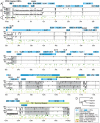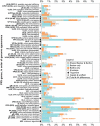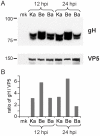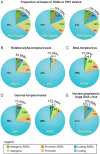A wide extent of inter-strain diversity in virulent and vaccine strains of alphaherpesviruses
- PMID: 22022263
- PMCID: PMC3192842
- DOI: 10.1371/journal.ppat.1002282
A wide extent of inter-strain diversity in virulent and vaccine strains of alphaherpesviruses
Abstract
Alphaherpesviruses are widespread in the human population, and include herpes simplex virus 1 (HSV-1) and 2, and varicella zoster virus (VZV). These viral pathogens cause epithelial lesions, and then infect the nervous system to cause lifelong latency, reactivation, and spread. A related veterinary herpesvirus, pseudorabies (PRV), causes similar disease in livestock that result in significant economic losses. Vaccines developed for VZV and PRV serve as useful models for the development of an HSV-1 vaccine. We present full genome sequence comparisons of the PRV vaccine strain Bartha, and two virulent PRV isolates, Kaplan and Becker. These genome sequences were determined by high-throughput sequencing and assembly, and present new insights into the attenuation of a mammalian alphaherpesvirus vaccine strain. We find many previously unknown coding differences between PRV Bartha and the virulent strains, including changes to the fusion proteins gH and gB, and over forty other viral proteins. Inter-strain variation in PRV protein sequences is much closer to levels previously observed for HSV-1 than for the highly stable VZV proteome. Almost 20% of the PRV genome contains tandem short sequence repeats (SSRs), a class of nucleic acids motifs whose length-variation has been associated with changes in DNA binding site efficiency, transcriptional regulation, and protein interactions. We find SSRs throughout the herpesvirus family, and provide the first global characterization of SSRs in viruses, both within and between strains. We find SSR length variation between different isolates of PRV and HSV-1, which may provide a new mechanism for phenotypic variation between strains. Finally, we detected a small number of polymorphic bases within each plaque-purified PRV strain, and we characterize the effect of passage and plaque-purification on these polymorphisms. These data add to growing evidence that even plaque-purified stocks of stable DNA viruses exhibit limited sequence heterogeneity, which likely seeds future strain evolution.
Conflict of interest statement
The authors have declared that no competing interests exist.
Figures








Similar articles
-
Emergence of a novel pathogenic recombinant virus from Bartha vaccine and variant pseudorabies virus in China.Transbound Emerg Dis. 2021 May;68(3):1454-1464. doi: 10.1111/tbed.13813. Epub 2020 Sep 8. Transbound Emerg Dis. 2021. PMID: 32857916
-
Proteomic Comparison of Three Wild-Type Pseudorabies Virus Strains and the Attenuated Bartha Strain Reveals Reduced Incorporation of Several Tegument Proteins in Bartha Virions.J Virol. 2022 Dec 21;96(24):e0115822. doi: 10.1128/jvi.01158-22. Epub 2022 Dec 1. J Virol. 2022. PMID: 36453884 Free PMC article.
-
Hyperphosphorylation of histone deacetylase 2 by alphaherpesvirus US3 kinases.J Virol. 2010 Oct;84(19):9666-76. doi: 10.1128/JVI.00981-10. Epub 2010 Jul 21. J Virol. 2010. PMID: 20660201 Free PMC article.
-
Recent Advances in the Study of Alphaherpesvirus Latency and Reactivation: Novel Guidance for the Design of Herpesvirus Live Vector Vaccines.Pathogens. 2024 Sep 10;13(9):779. doi: 10.3390/pathogens13090779. Pathogens. 2024. PMID: 39338969 Free PMC article. Review.
-
Possible roles of transcription factors of pseudorabies virus in neuropathogenicity.Fukuoka Igaku Zasshi. 2007 Oct;98(10):364-72. Fukuoka Igaku Zasshi. 2007. PMID: 18046989 Review.
Cited by
-
Viral infection of human neurons triggers strain-specific differences in host neuronal and viral transcriptomes.PLoS Pathog. 2021 Mar 22;17(3):e1009441. doi: 10.1371/journal.ppat.1009441. eCollection 2021 Mar. PLoS Pathog. 2021. PMID: 33750985 Free PMC article.
-
Genome-Wide Estimation of the Spontaneous Mutation Rate of Human Adenovirus 5 by High-Fidelity Deep Sequencing.PLoS Pathog. 2016 Nov 8;12(11):e1006013. doi: 10.1371/journal.ppat.1006013. eCollection 2016 Nov. PLoS Pathog. 2016. PMID: 27824949 Free PMC article.
-
In vivo imaging of alphaherpesvirus infection reveals synchronized activity dependent on axonal sorting of viral proteins.Proc Natl Acad Sci U S A. 2013 Sep 10;110(37):E3516-25. doi: 10.1073/pnas.1311062110. Epub 2013 Aug 26. Proc Natl Acad Sci U S A. 2013. PMID: 23980169 Free PMC article.
-
Dissecting the Herpesvirus Architecture by Targeted Proteolysis.J Virol. 2018 Aug 16;92(17):e00738-18. doi: 10.1128/JVI.00738-18. Print 2018 Sep 1. J Virol. 2018. PMID: 29899099 Free PMC article.
-
Pseudorabies Virus Infection Accelerates Degradation of the Kinesin-3 Motor KIF1A.J Virol. 2020 Apr 16;94(9):e01934-19. doi: 10.1128/JVI.01934-19. Print 2020 Apr 16. J Virol. 2020. PMID: 32075931 Free PMC article.
References
-
- Roizman B, Pellett PE. The family Herpesviridae: A brief introduction. In: Knipe DM, Howley PM, editors. Fields Virology 4 ed. Philadelphia: Lippincott Williams & Wilkins; 2001. pp. 2381–2397.
-
- Steiner I, Kennedy PG, Pachner AR. The neurotropic herpes viruses: herpes simplex and varicella-zoster. Lancet Neurol. 2007;6:1015–1028. - PubMed
-
- Mettenleiter TC, Keil GM, Fuchs W. Molecular Biology of Animal Herpesviruses. In: Mettenleiter TC, Sobrino F, editors. Animal viruses: molecular biology. xii. Norfolk, UK: Caister Academic Press; 2008. p. 531.
Publication types
MeSH terms
Substances
Associated data
- Actions
- Actions
- Actions
Grants and funding
LinkOut - more resources
Full Text Sources
Other Literature Sources

